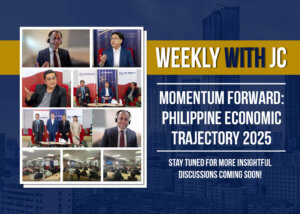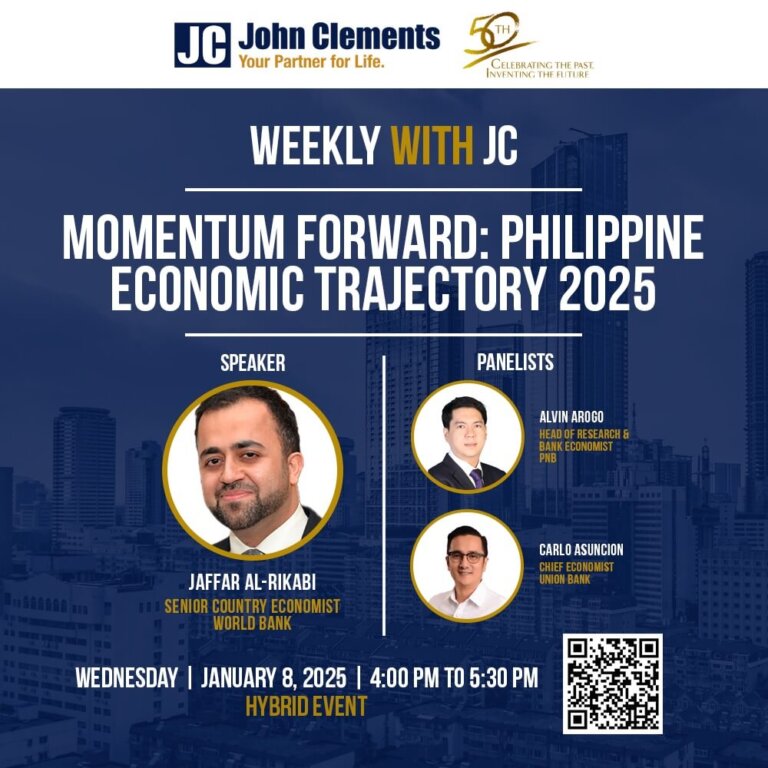As we enter 2025, the Philippines continues to demonstrate remarkable economic resilience and dynamism. This article highlights key insights from the recent Weekly with JC Economic Briefing, focusing on sustained growth, emerging risks, and the critical reforms necessary to secure long-term prosperity.
Introduction to the Speaker
Jaffar Al-Rikabi, a senior country economist from the World Bank, presented this comprehensive analysis. With extensive expertise in macroeconomic policy and development economics, Al-Rikabi has been instrumental in providing strategic insights to foster economic resilience and growth in emerging markets. His deep understanding of global and regional economic trends offers valuable perspectives for navigating the Philippines’ challenges and opportunities.
Sustained Economic Growth in 2024
For the second consecutive year, the Philippine economy has emerged as one of the fastest-growing in the East Asia Pacific region. Real GDP growth in 2024 is projected to average an impressive 5.8%, supported by a recovery in global goods trade and stable domestic economic policies. This growth momentum underscores the country’s ability to navigate global challenges effectively.
Projections for 2025–2026
Looking ahead, the Philippines is forecast to maintain robust growth, averaging 6.0% annually from 2025 to 2026. This trajectory is expected to be inclusive, driving further poverty reduction and fostering economic opportunities across the nation. However, the pace of growth, while commendable, reflects a slight deceleration compared to pre-pandemic levels, highlighting the need for sustained efforts to accelerate economic convergence with wealthier nations.
Global Economic Environment: A Mixed Picture
The global economy in 2024 delivered positive surprises, with stabilization and recovery in goods trade despite elevated financing costs and geopolitical tensions. Manufacturing activity in emerging markets, including the Philippines, benefited from this global uptick. Additionally, commodity prices moderated, and global financing conditions eased in the latter half of the year, creating a favorable backdrop for economic growth.
Nevertheless, global goods trade remains below pre-pandemic levels, signaling lingering challenges. Services trade showed continued stabilization, offering further support to the global economy.
Philippine Economic Performance: Key Drivers
Private consumption remained a cornerstone of growth in 2024, although its contribution moderated due to inflation and higher interest rates. This was offset by strong performances in capital formation, government consumption, and external demand. Notably, private investments and exports surged, driving overall economic resilience.
On the supply side, services continued to be the primary growth engine. The recovery in merchandise trade bolstered manufacturing, benefiting from improved global goods trade conditions. Additionally, the current account deficit narrowed in the first half of 2024, thanks to higher merchandise exports, enhancing economic stability.
Inflation and Monetary Policy
Inflation in the Philippines eased within the target range in 2024. However, high rice prices persisted, posing challenges to affordability. The Bangko Sentral ng Pilipinas (BSP) responded by reducing its key policy rate by 25 basis points in both August and October, citing an improved inflation outlook. These measures aim to support economic activity while maintaining price stability.
Emerging Risks and the Need for Reforms
Despite the positive outlook, downside risks loom large. The global environment remains uncertain, with external factors such as geopolitical tensions and volatile financial markets potentially impacting growth. To safeguard the country’s economic momentum, it is imperative to address these risks proactively. Below are key reforms essential to ensure sustained growth:
Enhancing Revenue Generation
The government’s fiscal consolidation efforts have largely focused on expenditure adjustments. However, to avoid cuts in critical capital spending, improving revenue generation is crucial. Strategies include closing compliance gaps, streamlining tax administration, and exploring policy measures to boost collections.
Accelerating Digital Transformation
Digitalization is a game-changer for economic competitiveness. Investments in digital infrastructure and policies to promote the digital economy can drive efficiency, innovation, and inclusive growth.
Investing in Human Capital
Building a competitive workforce requires sustained investments in education, healthcare, and skills development. Early childhood development, in particular, is a critical area for ensuring long-term economic productivity.
A Path Forward
The Philippines stands at a pivotal juncture. The achievements of 2024 highlight the country’s resilience and potential, but sustaining this momentum requires decisive action. By maintaining macro-fiscal stability and deepening structural reforms, the Philippines can secure its position as a dynamic upper middle-income economy and a beacon of growth in the region.
The road ahead is challenging but filled with opportunities. With strategic reforms and continued vigilance, the Philippines can achieve its aspirations of inclusive and sustainable development, ensuring a brighter future for all its citizens.

Stay Ahead with John Clements Consultants’ Events
Connect with us at John Clements Consultants to explore this event and other upcoming industry briefings. Learn how you can stay updated on future events, workshops, and valuable opportunities to engage with industry experts.





